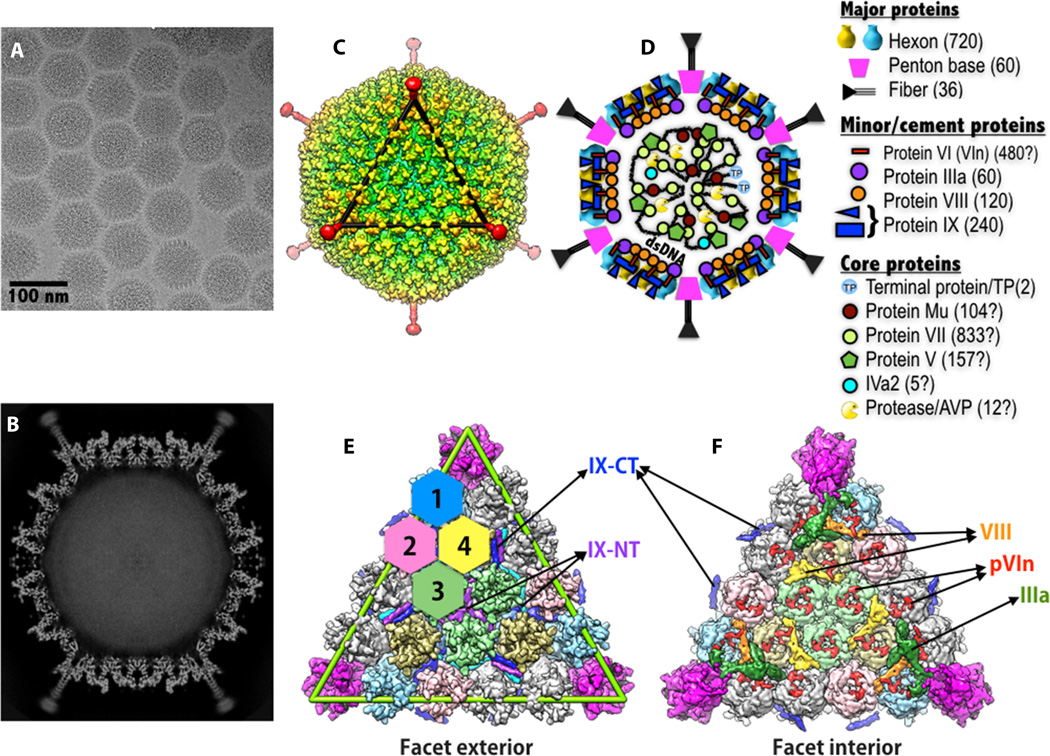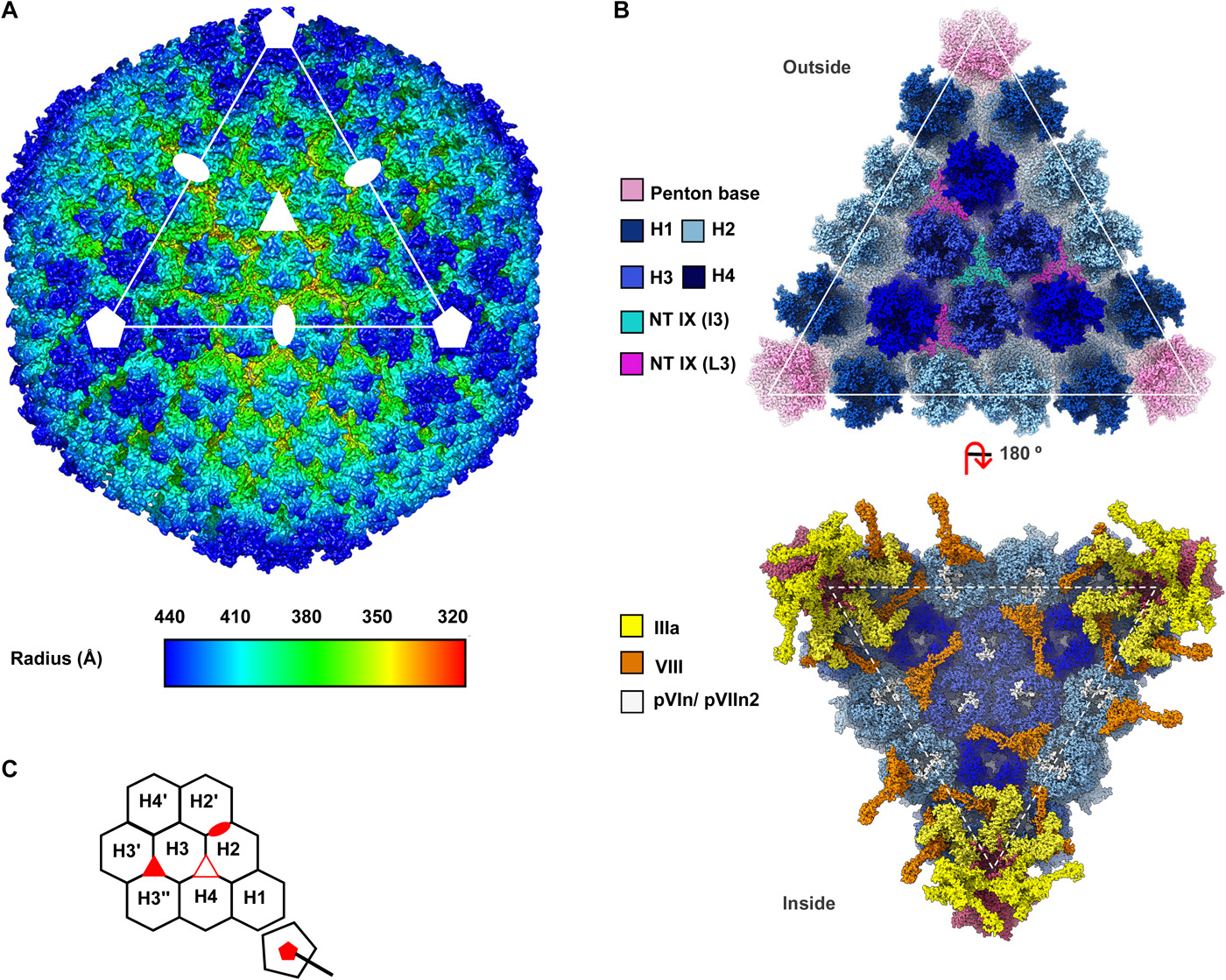Adenovirus (AdV) Structure Characterization Service | Cryo-EM
Adenovirus is a non-enveloped double-stranded DNA virus characterized by a highly symmetrical icosahedral capsid structure. It is widely used in fields such as gene therapy, vaccine delivery, and oncolytic virus development. Adenovirus (AdV) structure characterization is a high-resolution imaging technique based on cryogenic electron microscopy (Cryo-EM), specifically designed to analyze the three-dimensional structure and assembly state of adenoviruses (AdV). Cryo-EM preserves the native conformation of viral particles by rapidly freezing samples under liquid nitrogen conditions and imaging them without staining and under low-dose electron beam exposure.
The adenovirus (AdV) structure characterization service enables researchers to clearly visualize the adenoviral capsid architecture, assembly integrity, symmetry features, and the ratio of empty to full particles, supporting 3D reconstruction and detailed structural annotation. This service is broadly applied in structural optimization of adenoviral vectors, vaccine stability assessment, packaging efficiency evaluation, and quality control, providing essential structural insights and technical support for viral functional studies and formulation development.
Services at MtoZ Biolabs
Based on the high-end cryogenic electron microscopy platform, the adenovirus (AdV) structure characterization service based on Cryo-EM provided by MtoZ Biolabs enables rapid vitrification of adenovirus samples at liquid nitrogen temperature, preventing structural alterations caused by drying or staining and allowing for in situ high-resolution imaging of viral particles. This service delivers key data including the 3D structure of the adenovirus, capsid symmetry, assembly state, and the ratio of empty to full particles. It ensures nanometer-scale resolution and high structural fidelity, making it well-suited for vector quality assessment, structural optimization, and manufacturing process control.
Analysis Workflow
1. Sample Freezing Fixation
Adenovirus samples are rapidly cooled to liquid nitrogen temperature to form vitreous ice, preserving the native structure of the particles and preventing denaturation or aggregation.
2. Low-Dose Image Acquisition
High-contrast, low-dose two-dimensional images are captured using a cryogenic transmission electron microscope to ensure optimal image quality and structural integrity.
3. Image Processing and Particle Selection
Raw images are processed through denoising, alignment, and particle picking to extract high-quality viral particles for further analysis.
4. Three-Dimensional Reconstruction
Selected particles are used for 3D reconstruction to analyze capsid symmetry, assembly state, and the ratio of empty to full particles.
5. Data Reporting
A comprehensive report including raw images, 3D models, and structural analysis results is provided to support research, process optimization, and quality control.
Service Advantages
1. Accurate Preservation of Native Structure
Rapid freezing avoids conformational changes caused by drying or staining, fully preserving the adenovirus particles in their native state.
2. Nanometer-Scale Resolution Imaging
Using advanced Cryo-EM platforms, the service enables precise visualization of capsid symmetry, assembly integrity, and fine structural features.
3. Precise Differentiation of Empty and Full Particles
Quantitative analysis of the ratio of empty to full capsids supports evaluation of packaging efficiency and overall product quality.
4. Broad Serotype Compatibility
Compatible with wild-type, genetically modified, and vaccine-grade adenoviruses, offering wide applicability across research and development needs.
Applications
1. Gene Therapy Vector Development
The adenovirus (AdV) structure characterization service supports detailed analysis of adenoviral capsid architecture and assembly integrity, providing structural insights for the design and optimization of novel gene delivery systems.
2. Packaging Efficiency Evaluation
This service enables the distinction between empty and full particles, facilitating quantitative assessment of genome packaging efficiency to support process optimization.
3. Vaccine Structural Assessment
The adenovirus (AdV) structure characterization service allows for evaluation of capsid stability, assembly status, and packaging consistency in recombinant adenovirus vaccines, enhancing quality control measures.
4. Structural Biology Research
By analyzing capsid subunit organization, symmetry, and surface protrusions, the service contributes to deeper understanding of adenoviral infection mechanisms and structural function relationships.
Case Study
1. Cryo-EM Structure of Human Adenovirus D26 Reveals the Conservation of Structural Organization among Human Adenoviruses
This study utilized cryo-electron microscopy (Cryo-EM) to perform high-resolution structural analysis of human adenovirus type D26 (HAdV-D26), aiming to reveal its capsid architecture and structural conservation with other adenoviruses. A 3.7 Å resolution 3D reconstruction was obtained, demonstrating that the overall capsid organization and spatial arrangement of major structural proteins in HAdV-D26 are highly similar to those of HAdV-C5, despite genetic differences. Cryo-EM clearly resolved the conformations of hypervariable regions (HVRs) in the hexon protein, the hexagonal lattice organization of protein IX on the capsid exterior, and the precise localization of proteins IIIa and VI within the capsid interior, elucidating the structural principles of adenoviral capsid assembly. The findings highlight Cryo-EM as a powerful tool for accurately preserving the native architecture of adenovirus particles and provide critical structural insights for understanding viral assembly and for advancing adenoviral vector design and vaccine development.

Yu, X D. et al. Science Advances, 2017.
Figure 1. Overall Structure and Organization of the Major and Minor Capsid Proteins in HAdV-D26.
2. Cryo-EM Structure of Enteric Adenovirus HAdV-F41 Highlights Structural Variations among Human Adenoviruses
This study employed cryo-electron microscopy (Cryo-EM) to conduct high-resolution structural analysis of human enteric adenovirus HAdV-F41, aiming to uncover its unique capsid architecture and structural differences from other adenoviruses. A 4.0 Å resolution 3D reconstruction revealed that, while the core structural proteins such as the hexon and penton base remain conserved, HAdV-F41 exhibits partially ordered structural features at the vertex region that may contribute to enhanced stability in the gastrointestinal environment. More notably, the external arrangement of protein IX differs significantly from that of all previously characterized human and non-human adenoviruses, suggesting a virus-specific structural adaptation mechanism. The study highlights Cryo-EM as a powerful tool for accurately resolving spatial structural variations in adenoviral particles, providing crucial insights into adenovirus diversity and tissue adaptation, and offering a valuable structural basis for the development of oral vaccines and gut-targeted adenoviral vectors.

Pérez-Illana, M. et al. Science Advances, 2021.
Figure 2. The Cryo-EM Structure of HAdV-F41 at 4.0 Å.
FAQ
Q1: Does Cryo-EM Imaging Damage the Structure of Adenovirus Particles?
A1: No. Cryo-EM uses low-dose electron beam imaging combined with rapid freezing, which effectively preserves the structural integrity of adenovirus particles. It is currently the leading method for in situ structural analysis of viruses.
Q2: Can Cryo-EM Distinguish between Empty and Full Adenovirus Particles?
A2: Yes. By analyzing image density and performing 3D reconstruction, Cryo-EM can reliably differentiate empty capsids (lacking DNA) from full particles (containing the packaged genome), and quantify their proportions to evaluate packaging efficiency.
How to order?







